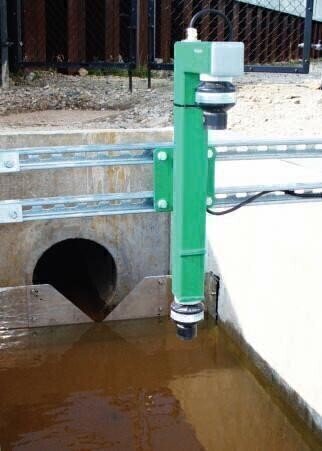Measurement and Testing
Excellent Measurement Accuracy in Airport’s Critical API Hydrocarbon Separator Unit
Apr 09 2010
Pulsar Process Measurement (UK) have supplied a non-contacting ultrasonic open channel flow measurement system featuring their DUET transducer array to give excellent measurement accuracy in the airport’s critical API hydrocarbon separation unit. Pulsar’s FlowCERT system featuring the DUET transducer has achieved Class 1 MCERTs certification.
Surface water runoff in an area as large as a major airport is considerable, and in certain areas may be mixed with aviation fuel, oil and other contaminants, so it has to be treated in the same way as any other industrial effluent before it can be discharged. That means separation, treatment and measurement of the final effluent flow, which is where Pulsar comes in.
Pulsar supplied a v-notch weir plate along with a DUET transducer array and FlowCERT control unit to measure effluent flow through an open channel. As can be seen in the picture, the channel was in an exposed position, where solar radiation can be a significant factor affecting the accuracy of the measurement. The v-notch weir plate was sized for a maximum flow rate of 25 litres per second, although the actual flow can be
very small indeed in dry periods of the year. It is vital that the measurement remains reliable and accurate. The measurement of this type of application is particularly difficult; the ultrasonic technique is based on the measurement of the time taken for an echo to return to the face of a transducer, which is in turn dependent on the speed of sound. The speed of sound in air varies with air density, which is affected by air temperature. If the measurement device does not compensate quickly and accurately, errors are introduced into the result. In this case, because the head varies by around 200mm between high flow and zero, it is crucial that the measurement is accurate and repeatable right down to the very lowest flows, and records a genuine zero when there is no flow at all.
DUET is perfect for this type of application, consisting as it does of an array of two transducers that fire ultrasonic pulses simultaneously, which are then received at the lower transducer only. The FlowCERT controller then compares the two returning echoes. The two transducers are mounted on a heavy frame and the separation of the two transducers is a fixed distance, so any changes in the measured distance when comparing the two ultrasonic pulses must be down to variations in the speed of sound. This strategy allows the FlowCERT controller to compensate dynamically and accurately for these variances, applying that compensation to the flow measurement. Under MCERTs tests, this unique system has allowed FlowCERT and DUET to achieve industry-leading total error levels of only 0.037%, even under the new, stringent, solar radiation test.
As Mark Stewart, the Airport’s Water Services Engineer in charge of the project, put it: ‘We were very pleased with the way that Pulsar responded to the project brief, and have been delighted with the performance of the DUET. We’re confident about the measurement, so we know we are submitting exactly the right figures to the EA. We’re now in the process of standardising on Pulsar equipment for all our flow and level measurement applications’.
Digital Edition
PIN 25.1 Feb/March
March 2024
In This Edition Safety - The technology behind the ION Science Tiger XT - Safety with ammonia and LOHCs as hydrogen carriers Analytical Instrumentation - Discussion on new tribology te...
View all digital editions
Events
Apr 30 2024 Birmingham, UK
May 03 2024 Seoul, South Korea
May 05 2024 Seville, Spain
May 06 2024 Riyadh, Saudi Arabia
May 06 2024 Houston, Tx, USA


















